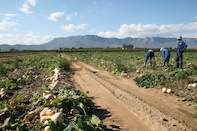Propagation
Propagation of Butternut squash is from seed.
Planting Method
Seeds are planted by hand and by mechanical planters. The butternut seeds are planted directly into the prepared planting rows. Seeds are planted 2.5 cm to 3 cm deep.
At each seed site plant 2 seeds 10 cm apart to ensure coverage. Excess butternut seedlings can be removed and planted elsewhere if both seeds have germinated. The strongest can be kept.
Spacing
Plants should be spaced 30 cm to 40 cm apart in rows that are 120 cm apart. This is between 20 000 and 30 000 butternut plants per hectare.Planting Time
Butternuts are a warm weather vegetable, thus planting occurs from early spring to mid-summer. In South Africa planting starts in August where the temperatures have started to increase after the winter.
In areas where there is the risk of frost and low temperatures still occurring, planting will only start in September. Planting can extend into early December if the mid-summer temperatures are not regularly above 35°C.
Growth Period
Butternut growing period is normally between 12 and 15 weeks from planting of the seed to the first butternuts being ready to harvest.Fertilization
Start preparing the plant area at least a month before planting. If the soil requires composting, start by applying approximately 20 m³ to 30 m³ of manure or compost per hectare and ploughing this into the top 300 mm of soil.
The soil is then left to settle with the compost and then the plant rows are prepared. Once the seeds have germinated and the young seedlings have established themselves, apply between 400 and 600 kilograms of 2:3:4 (30) per hectare along the plant lanes.
A final application of nitrogen in the form of 250 kilograms of LAN (Limestone Ammonium Nitrate) must be done five to six weeks after planting to boost fruit development once the first butternuts have formed.
Irrigation
Butternut has quite a deep root system with some roots growing down to a meter if the soil is good and well prepared and this makes it possible for the plants to cope with some level of moisture stress, however it is still important to ensure that the soil remains moist.
Irrigate between 25 mm and 35 mm per week during the growing period. Adequate water in the root zone is essential for good flowering and fruit set.
By Louise Brodie